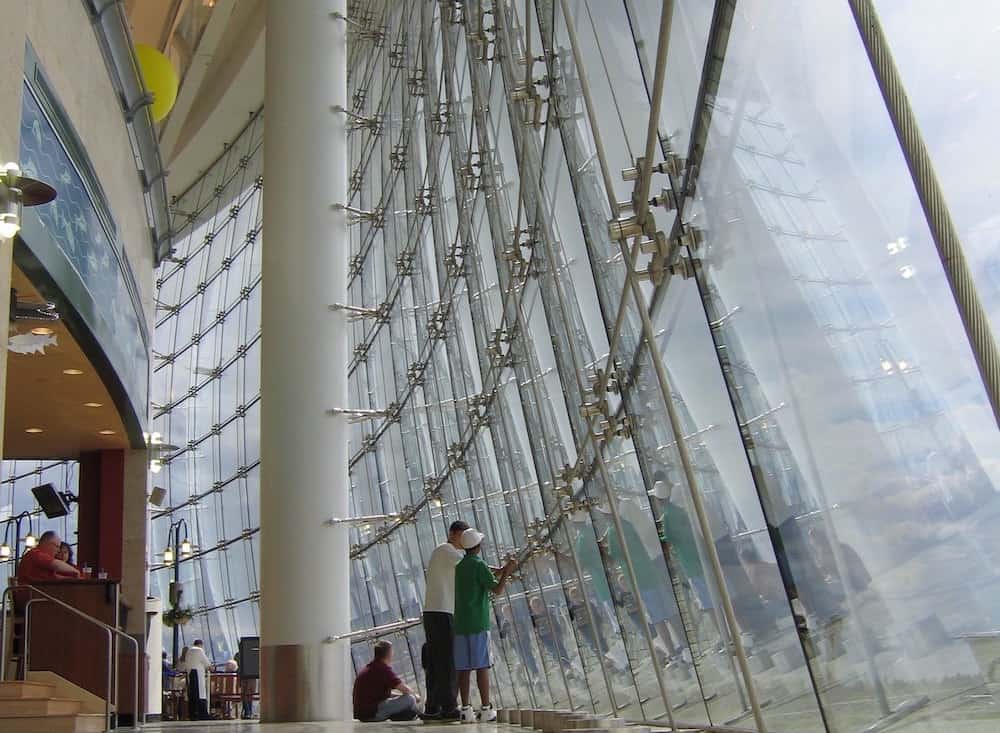
[Image above] Example of a curved glass curtain wall at the Seattle-Tacoma International Airport. Credit: Michael Hanscom, Flickr (CC BY-NC-SA 2.0)
With all that has transpired due to the COVID-19 pandemic in the past two years, it can be hard to remember the events that gripped world news before March 2020. A recent newsletter from National Geographic, however, reminded me of a project that is just now reaching the construction phase—restoration of the Notre-Dame cathedral in Paris.
On April 15, 2019, a fire broke out beneath the roof of Notre-Dame. By the time the fire was extinguished, the cathedral’s spire had collapsed, most of its roof was destroyed, and its upper walls were severely damaged.
Construction crews have spent the past two and a half years performing cleaning and stabilization work before commencing reconstruction. Now, attention has turned to validating plans for the restoration.
As a Bloomberg article explains, these plans haven’t been without controversy. While the proposed plans would largely restore Notre-Dame as it was before the 2019 fire, there are some proposed changes to improve visitor experience, such as a different entrance for the public. These changes are being criticized by those who view them as threatening the integrity of the medieval structure.
Yet this argument is not without irony, the Bloomberg article notes.
“Notre Dame’s pre-fire appearance is itself the product of another era’s far more obtrusive cultural meddling. As a ‘palimpsest’ that has been shaped and reshaped across the centuries, the church’s appearance changed drastically in the 19th century, when architect-restorer Eugène-Emmanuel Viollet-le-Duc repaired and renewed it with a decidedly Victorian take on France’s Gothic past. … The changes, wrote British writer and art critic John Ruskin, were ‘a lie from beginning to end’ reflecting not a repair of the original but ‘the most complete destruction that an edifice can suffer.’”
Seeing these discussions surrounding Notre-Dame’s reconstruction provides an appreciation for how architecture is about much more than just utility—architecture reflects a culture’s values as well.
Curtain walls are an example of an increasingly popular design element that serves mainly an aesthetic rather than structural purpose. These non-load-bearing frames trace their origins to the beginning of the 19th century, when architects started transitioning away from relying on exterior walls to support the roof and instead relying on sturdy columns with greater load-bearing capacity to provide structural support. This transition opened the way to replace the masonry exterior wall with a lightweight transparent “curtain” wall, which no longer had a load-bearing role but still offered protection from rain intrusion and heat loss.
The thin aluminum frame of a curtain wall can be filled with various materials, but glass is one of the most popular choices. Curtain wall glass is often manufactured using cold bending, which involves attaching planar glass sheets to the curved aluminum frame so that it deforms within an allowable range of stress to achieve a curved effect.
After glass is cold bent, residual stress remains in it even after installation. If this stress is greater than the strength of the glass, the curtain wall will eventually break. “Therefore, studying the stress state of glass cold bending has become the basis for the application of curtain wall cold bending methods,” researchers write in a recent paper.
The researchers come from Northeastern University and Avic Xi’an Aircraft Industry Group Co., Ltd. in China. In their study, they look to develop an analysis model to determine the cold-bending stress on a glass surface.
They explain that it is “impossible” to account for all the factors involved during the glass cold-bending process, such as volatility of material properties and geometric parameters, and these uncertainties lead to many random variables that increase the complexity of simulations. So, researchers have proposed a variety of models to reduce complexity.
Based on these previous results, the researchers developed their own method based on finite element analysis. They compared the predictions of their model to experimental results and also performed reliability and sensitivity analyses using Monte Carlo and adaptive Kriging-Monte Carlo simulations.
Based on comparison of the simulated and experimental results of the stress and displacement of each measuring point of the curtain wall glass, the researchers concluded that their finite element method “is realistic and can be used to formulate the limit state function for the cold-bending reliability and sensitivity analysis of curtain wall glass.”
In addition, the adaptive Kriging-Monte Carlo simulations demonstrated high computational efficiency and fast convergence speed and met the accuracy requirements for reliability analysis.
“Therefore, [Kriging-Monte Carlo simulation] is especially suitable for the reliability and sensitivity analysis of cold-bent curtain wall glass,” they write.
The researchers write that future studies should consider the influence of support flexibility and support conditions on the reliability of cold-bent curtain wall glass.
“In addition, it is recommended that future studies further develop experiments and [finite element analysis] to make the cold bending stress of glass reach the tensile bending strength of glass, so as to further evaluate the buckling performance of glass,” they write.
The paper, published in Journal of Building Engineering, is “Reliability and sensitivity analysis of cold-bent curtain wall glass” (DOI: 10.1016/j.jobe.2022.104116).
Author
Lisa McDonald
CTT Categories
- Construction
- Glass
- Modeling & Simulation


